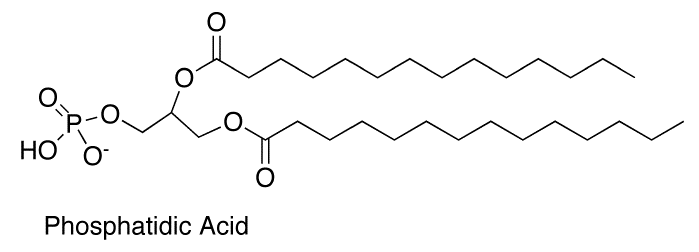Function and Analysis of Phosphatidic Acid

Phosphatidic acid (PA) is a simple phospholipid consisting of a glycerol group, a fatty acid group, and a phosphate group. The types of fatty acid include palmitic acid, stearic acid, oleic acid, linoleic acid, linolenic acid, and arachidonic acid. The PA molecule is an acidic compound with a negative charge. PA can be used in the food industry, pharmaceutical industry, cosmetics and other applications.

Function of phosphatidic acid
PA is found in plant and animal cells and is an essential component of the cell membrane, nuclear membrane, and plasma membrane of plants and animals, and is the basic substance of life. PA is an important intracellular second messenger that plays a role in many cellular functions.
PA is a direct product of the action of phospholipase D (PLD). In the cellular activation state, PA induces calcium mobilization and activates or co-activates various intracellular enzymes, such as phosphodiesterase (PDE), and protein kinase C (PKC), and reduces nikinamide adenine dinucleotide phosphate (NADPH) oxidase.
On this basis, PA produces various cellular effects, mainly in the following areas.
- Promote cell mitosis
PA plays a role in mitogen-induced mitosis in a variety of cells (hepatic astrocytes, B lymphocytes, etc.). It can also directly induce proliferation of mammary epithelial cells, osteoblasts, and T lymphocytes in vitro.
- Promote intracellular superoxide formation
Neutrophils are key members of the host innate immune response, and these phagocytes act as bactericidal cells mainly by respiratory bursts to produce superoxide anions. NADPH oxidase consists of a combination of cytoplasmic and membrane-bound proteins. When multiple components of NADPH oxidase are phosphorylated, the cytoplasmic component is transferred to the cytosolic membrane where it assembles with the membrane component to form an active enzyme. PA activates a variety of protein kinases, including PKC isozymes, P21 (Cde42/Rac)-activated protein kinase, MAPK and thus phosphorylates p47phox.
- Promote hormone secretion
The extracellular release of hormones is a complex process, and the factors regulating secretion require the participation of various cytoplasmic proteins in addition to calcium ions and ATP, and various lipids have certain regulatory roles.
Detection of phosphatidic acid
- High-Performance Liquid Chromatography (HPLC)
The principle of HPLC is that the separated mixture is pushed into the column by the mobile phase liquid, and the separation is performed according to the differences in adsorption capacity, partition coefficient, ion exchange effect or molecular size of each component in the stationary phase and mobile phase. The HPLC method has the advantages of convenience, rapidity, accuracy, high sensitivity, system confinement to avoid oxidation of unsaturated bonds, and does not require high-temperature operation, and is currently the mainstream method for phospholipid analysis.
- LC- MS/MS method
LC-QTRAP-MS/MS technology with MRM scanning mode allows phosphatidic acid targeted quantification on a wide range of samples, such as animal and plant cells, food, pharmaceutical products, and cosmetics. Compared to HPLC, it has higher sensitivity, selectivity, resolution and throughput.
- Art
- Causes
- Crafts
- Dance
- Drinks
- Film
- Fitness
- Food
- Games
- Gardening
- Health
- Home
- Literature
- Music
- Networking
- Other
- Party
- Religion
- Shopping
- Sports
- Theater
- Wellness


